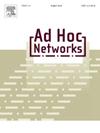农村地区物联网节点到无人机定时传输的基于lora的系统设计与分析
IF 4.4
3区 计算机科学
Q1 COMPUTER SCIENCE, INFORMATION SYSTEMS
引用次数: 0
摘要
本文考虑部署在没有地面互联网连接和本地能源供应的农村地区的低功率广域网(LPWAN)物联网设备。这些设备配备了传感器,可以持续监测地面状况,并使用LoRa/LoRaWAN技术将测量结果发送到互联网,利用固定翼无人机(uav)的偶尔连接。本工作提出了一种协调无人机通道与智能农业地面节点传输的方法,以允许对无人机上的LoRa网关进行预定访问。建立了一个测试平台来研究LoRa ISM在868 MHz频段的传播。然后,设计了一个基于航路点的无人机封闭路径,其中航路点被确定为物联网节点位置上k-means聚类方案的质心。基于Matlab无人机模拟器,确定无人机飞行轨迹,确定各地面节点向无人机传输信号的时间间隔;这些间隔用于调度这些节点的传输。我们根据与中断事件、数据包冲突以及无人机可见间隔太短导致某个节点无法向无人机发送数据的风险相关的不同指标来评估该无人机访问方案的性能。研究了不同的权衡,表明使用较小的扩展因子(SF)值和选择最大可能的无人机飞行高度更便于实现在一个无人机飞行周期内从节点收集数据的高概率。本文章由计算机程序翻译,如有差异,请以英文原文为准。
Design and analysis of a LoRa-based system with scheduled transmissions from IoT nodes to UAV in rural areas
This paper considers Low Power Wide Area Network (LPWAN) IoT devices deployed in rural areas without terrestrial Internet connectivity and local energy supply. These devices are equipped with sensors to continuously monitor ground conditions and deliver measurements to the Internet using the LoRa/LoRaWAN technology, exploiting the occasional connectivity to fixed-wing Unmanned Aerial Vehicles (UAVs). This work proposes an approach to coordinate the UAV pass with the transmissions of ground nodes for smart agriculture to allow scheduled access to the LoRa gateway onboard the UAV. A testbed has been developed to study the propagation in the LoRa ISM band at 868 MHz. Then, a waypoint-based UAV closed path is devised, where the waypoints are determined as the centroids of the k-means clustering scheme on IoT node locations. Based on the Matlab UAV simulator, we determine the UAV flight trajectory and identify the intervals during which each ground node can transmit to the UAV; these intervals are used to schedule the transmissions of these nodes. We evaluate the performance of this UAV access scheme in terms of different indicators related to outage events, packet collisions, and the risk that the visibility interval of the UAV is too short for a certain node to allow it to send data to the UAV. We investigate different tradeoffs, showing that using small Spreading Factor (SF) values and selecting the maximum possible UAV flight altitude is more convenient for achieving a high probability of collecting data from the nodes in one UAV flight cycle.
求助全文
通过发布文献求助,成功后即可免费获取论文全文。
去求助
来源期刊

Ad Hoc Networks
工程技术-电信学
CiteScore
10.20
自引率
4.20%
发文量
131
审稿时长
4.8 months
期刊介绍:
The Ad Hoc Networks is an international and archival journal providing a publication vehicle for complete coverage of all topics of interest to those involved in ad hoc and sensor networking areas. The Ad Hoc Networks considers original, high quality and unpublished contributions addressing all aspects of ad hoc and sensor networks. Specific areas of interest include, but are not limited to:
Mobile and Wireless Ad Hoc Networks
Sensor Networks
Wireless Local and Personal Area Networks
Home Networks
Ad Hoc Networks of Autonomous Intelligent Systems
Novel Architectures for Ad Hoc and Sensor Networks
Self-organizing Network Architectures and Protocols
Transport Layer Protocols
Routing protocols (unicast, multicast, geocast, etc.)
Media Access Control Techniques
Error Control Schemes
Power-Aware, Low-Power and Energy-Efficient Designs
Synchronization and Scheduling Issues
Mobility Management
Mobility-Tolerant Communication Protocols
Location Tracking and Location-based Services
Resource and Information Management
Security and Fault-Tolerance Issues
Hardware and Software Platforms, Systems, and Testbeds
Experimental and Prototype Results
Quality-of-Service Issues
Cross-Layer Interactions
Scalability Issues
Performance Analysis and Simulation of Protocols.
 求助内容:
求助内容: 应助结果提醒方式:
应助结果提醒方式:


